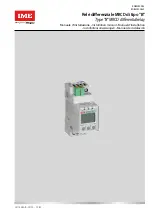
APPENDIX
181
NA30 - Manual - 04 - 2022
8.3 APPENDIX A3 - Inverse time - RECTIFIER, I
2
t and EM curves
Mathematical formula
The mathematical formula for RECTIFIER, I-squared-t (I
2
t) and Electromechanical curves (EM) is:
[1]
Where:
• t
= operate time (in seconds)
• t
I>inv
= setting time multiplier (in seconds)
• I
= input current
• I
>
inv
= threshold setting
K
= coefficient:
• K
= 2351 for RECTIFIER curve (RI)
• K
= 16 for I
2
t curve
• K
= 0.28 for Electromechanical curve (EM)
α
= curve shape constant:
• α
= 5.6 for RECTIFIER curve (RI)
• α
= 2 for I-squared-t (I
2
t) curve
• α
= -1 for Electromechanical curve (EM)
A
= coefficient:
• A
= 1 for RECTIFIER curve (RI)
• A
= 1 for I-squared-t (I
2
t) curve
• A
= -0.236 for Electromechanical curve (EM)
B
= coefficient:
• B
= 1 for RECTIFIER curve (RI)
• B
= 0 for I-squared-t (I
2
t) curve
• B
= -0.339 for Electromechanical curve (EM)
For all inverse time characteristics, following data applies:
• Asymptotic reference value (minimum pickup value): 1.1
I
>
inv
• Minimum operate time: 0.1
s
• Range where the equation is valid:
[2][3]
1.1 ≤
I
/
I
>
inv
≤ 20
• If
I
> pickup ≥ 2.5
I
n
, the upper limit is 50
I
n
Note 1 Symbols are concerning the overcurrent element. The comprehensive overview of the inverse time characteristics concerning the 50/51 and
50N/51N elements is dealt within the PROTECTIVE ELEMENTS section
Note 2 When the input value is more than 20 times the set point , the operate time is limited to the value corresponding to 20 times the set point
Nota 3 With setting more than 2.5 In for the 50/51 elements and 0.5 IEn for the 50N/51N elements, the upper limit of the measuring range is limited to 50
In and 10 IEn respectively.
t
=
t
>
inv
·
A·(
I
/
I
>
inv
)
α
-B]
K
















































